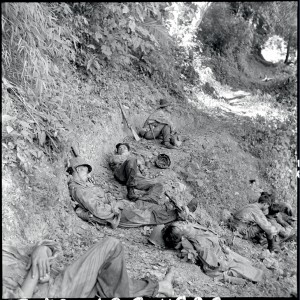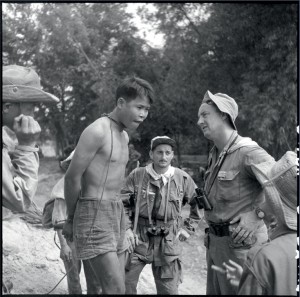Between 1946 and 1954, France, supported by the USA, fought the Viet Minh independence forces in French Indochina, who were backed by the People’s Republic of China from 1949 onwards. For tens of thousands of French soldiers, the end of the Second World War did not mean an end to hostilities.
 Paul Corcuff was among them. Enlisting in June 1944, he left for French Indochina in June 1949 as a reporter and photographer and followed the military operations closely. In October 1952 he was with the 6th Colonial Paratroopers’ Battalion (BPC) led by Commandant (Major) Bigeard. Parachuted in alongside the soldiers, he accompanied them in their withdrawal towards the Black River, sharing their living conditions and their exhaustion. Taken from within, showing combat preparations and thedifficulty of the retreat, his photographs are branded with the heat of lived experience. Does this make Paul Corcuff a reporter in the true sense of the term, using photography to convey an original story or message?
Paul Corcuff was among them. Enlisting in June 1944, he left for French Indochina in June 1949 as a reporter and photographer and followed the military operations closely. In October 1952 he was with the 6th Colonial Paratroopers’ Battalion (BPC) led by Commandant (Major) Bigeard. Parachuted in alongside the soldiers, he accompanied them in their withdrawal towards the Black River, sharing their living conditions and their exhaustion. Taken from within, showing combat preparations and thedifficulty of the retreat, his photographs are branded with the heat of lived experience. Does this make Paul Corcuff a reporter in the true sense of the term, using photography to convey an original story or message?

 Commissioned by the press information service (SPI) in French Indochina, he had no say in the use made of his images, which were subject to the imperatives of information control before being circulated to the international press. The photographs he took reflect reality on the ground, but the selection made of them had to fit into France’s wider communication strategy. The presentation of the military operations in French Indochina was subject to the French government’s specific communication objectives within a tense international context.
Commissioned by the press information service (SPI) in French Indochina, he had no say in the use made of his images, which were subject to the imperatives of information control before being circulated to the international press. The photographs he took reflect reality on the ground, but the selection made of them had to fit into France’s wider communication strategy. The presentation of the military operations in French Indochina was subject to the French government’s specific communication objectives within a tense international context.
Mentioned in dispatches for his reporting on Tu Lé, “as precious to the High Command as to the international media”, Paul Corcuff was a real soldier of the photographic image.
Crédits photos : © ECPAD / Paul Corcuff




Ajouter un commentaire